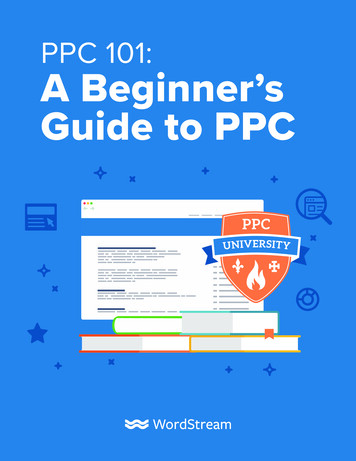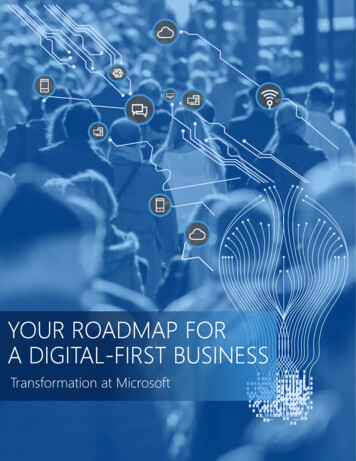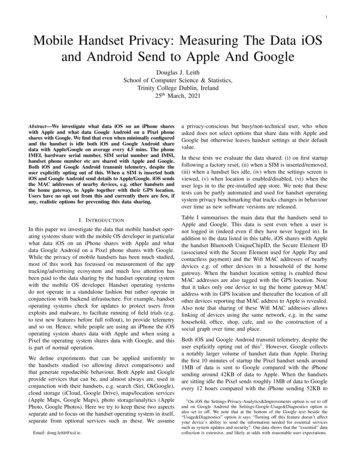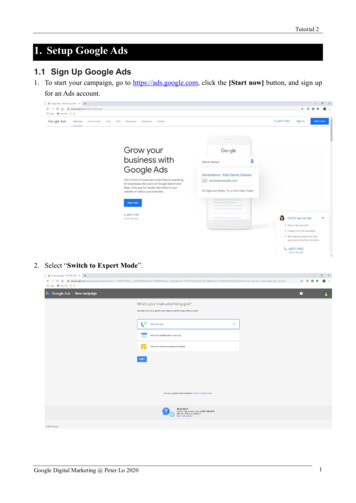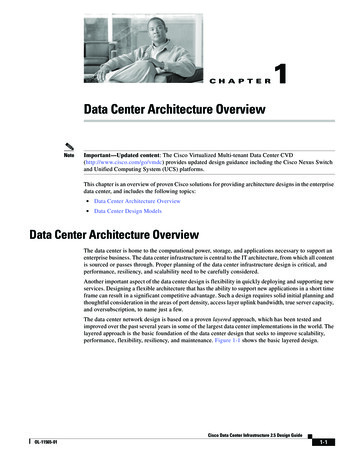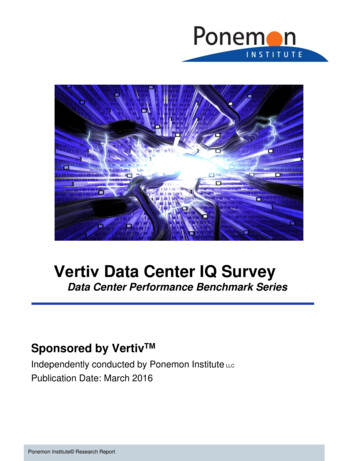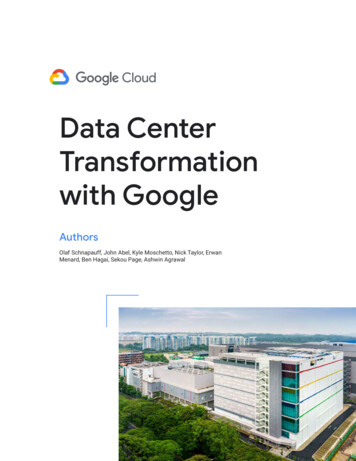
Transcription
Data CenterTransformationwith GoogleAuthorsOlaf Schnapauff, John Abel, Kyle Moschetto, Nick Taylor, ErwanMenard, Ben Hagai, Sekou Page, Ashwin Agrawal
Table ofcontents02.Table of contents04.Introduction05.Going with Google Cloud07.The road ahead07.Hedge your bets07.Going all in07.Prepare for your journey10.Choose your path10.The more clouds, the better11.Making business sense of Cloud11.Great expectations11.Rich Cloud, poor Cloud11.Cloud on a budget13.Take your first steps15.Evolve your culture16.15.Building a Cloud operating model16.Procurement for the CloudGo big16.In with the old17.Everything is software17.It’s the network18.It’s still the network18.Don’t forget the fine print2
19.Make the move21.Discover and assess22.Plan22.Foundational architecture23.Migrate24.Optimize24.We’re in it together24.Google Cloud partners24.Google Cloud professional services25.You’re not alone27.Where to go from here27.Path forward for your IT assets27.Path forward for your workloads28.So, what’s next?29.Appendix A:Data center to Cloud asset maps34.Appendix B:Additional reading3
IntroductionAt Google, we understand and embrace the fact that we’re not a first moveras a public cloud provider. Rather, our move to cloud is focused on finding theright capability for the right customer problems, to drive real value and minimizecomplexity. Our cloud is different because Google is a different technologycompany. We’re not a retailer or a software company trying to leverage yourtechnical debt for a healthy balance sheet. We exist to help you leverage data, andengage with you securely at massive scale. This is our focus. We went throughthe journey to cloud ourselves first, and then decided to productize our technologyand expertise to share with others. Along the way, we open sourced criticaltechnologies such as Kubernetes, to make them better and serve the world.1ForresterPublic Cloud Evolution 20182IDCCloud Pulse 2019We’ve found that enterprises developing digital leadership increasingly move out of their data centers to focuson core business innovation, and save on complex infrastructure costs. This trend is reinforced by recent globalmacroeconomic events, like the COVID-19 pandemic and volatile oil prices, and microeconomic events in certainindustries, such as the emergence of disruptors or massive swings in customer bases. This puts challengesrelated to demand peaks (e.g. remote workers VDI needs) and business continuity under a magnifying glass.Many CIOs are under pressure to complete migrations quickly - 68% of CIOs are seeking to migrate existingapplications to the cloud ¹, with 75% of all enterprise workloads not yet migrated ². Motivations range from costor risk reductions, to refocusing on agility and speed. As they assess their options, many enterprises face anenormous challenge of balancing the function of their existing infrastructure with a new operating model in thecloud. This involves thousands of variables, different technologies, different processes and skills, disparateteams, and competing interests.At Google, we’re here to help you navigate and execute data center transformations to lower risk and cost,while maximizing business value. We’ve already done this with customers such as Cardinal Health, Sabre,Loblaw Digital, Bitly, Boa Vista, and Credit Karma and have a complete set of solutions that are purpose built toserve the enterprise. From mainframe to cloud-native, we help enterprises like yours move to the cloud whilehelping decide what’s right for each organization individually. And we develop services, experience, expertiseand technology in order to migrate and then modernize any kind of enterprise workload and data center asset.This guide is intended to help you craft your strategy out of the data center and into public cloud. It surfacestypical industry patterns, key dimensions to be taken into account while designing the journey, as well asGoogle’s capabilities and approach to executing a successful modernization, to help you drive lower costs andincreased agility.4
Going with Google CloudWhen IT departments first had the option of cloud, it was not embraced with openarms. But underlying drivers have evolved over the years, from cloud being simplya route to cost-savings, to a means for scaling business operations, to an enablerof digital transformation. Today, the question is not whether or not the cloud canbe viable, but rather how one might take advantage of all the cloud has to offer.Whether your organization has just started planning or has already made the move,the strategic decision of choosing the right cloud partner for this journey is critical.3Forrester Research names GoogleCloud a Leader in Public CloudPlatform Native Security Wave.Forrester Research names GoogleCloud a Leader in the Data SecurityPortfolio Vendors WaveAlphabet has 9 products with over 1 billion users each. Google Cloud customersbenefit from the storage architecture to edge network devices that have beenproven to support our own products at scale, with data centers 100% owned andoperated by Google. No other cloud provider can make this claim. We have beenrunning the world’s most used platforms at scale for years, and bring that expertiseto our customers.Any cloud provider can offer the basics necessary to host services andapplications. While Google Cloud certainly provides the foundations one wouldexpect from cloud, such as storage and compute, we go beyond these to providebest in class and innovative services that only Google can deliver. This is whatmakes our cloud different.Best in class securityWe deliver end-to-end security solutions from the data center all the way to the device with a purposebuilt infrastructure and security by default. Only Google Cloud is named a leader in both data securityand public cloud-native security according to Forrester.³Hybrid and Multi-CloudWe believe in an open cloud and we have designed Google Cloud to support whatever system bestsuits your needs, whether hybrid or multi-cloud. Our open source DNA influenced how we developedAnthos, an open hybrid and multi-cloud platform, not locked to proprietary hardware you might see withother clouds. By extending our cloud to the data center in an open manner, the first step towards cloudmigration is made without any strings attached.Full managed no opsWe strive to make cloud easy to use - automating manual tasks and configuration wherever possible soyour teams can focus on development and less on managing infrastructure. We extend this approachnot only to our technical solutions like BigQuery, but to how we think about saving you money on ourplatform through automatic discounts that we apply by default on your behalf.5
Embedded AI and MLWe embed intelligence in everything, making it easy for you to applyartificial intelligence and machine learning (AI/ML) in your ownorganization. Although all vendors have AI/ML, our customers quicklyfind that the Google AI Platform produces a different level of results.Our AI benefits from deep integration with Big Data analytics and fromYouTube, Google Search, and more as part of the training models behindthe algorithms. Our leader position in this space according to Forresterproves not all AI/ML platforms are the same.44The Forrester New Wave :Computer Vision Platforms,Q4 2019SustainabilityWe match 100% of the energy consumed by its global operations with renewable energy, and maintain acommitment to carbon neutrality. Google was the only cloud Infrastructure as a Service global provider graded “A”by Greenpeace.Best of GoogleWe bring you the best of Google in our solutions, and we can help you create a more innovative and collaborativeculture in your organization. Google Cloud brings the best of Google’s innovative products and services to enableenterprises to create new user experiences, transform their operations and launch new products.We’ve done this beforeNot only have we run and grown our own portfolio of multiple billion-user products for years, we’ve helped ourcustomers take advantage of all that Google has to offer from our technology to our culture.6
The road aheadYou’ll likely have many variables to consider when choosing an approach to datacenter migration. Typical considerations include whether you want to partiallyor completely exit the data centers, and the best time frames for doing so. Thedifferentiating business value of the workloads being migrated, the desire fortransformation, and the organizational readiness for cloud adoption all need to beexamined. Balancing all of this can be complex when considering a large IT estate.An assessment of your organization’s desired end-state, both technically andorganizationally, informs the default approach to migration. We provide a variety oftechnologies and professional services offerings to make transformation easier,and a compelling platform for rehosting of legacy workloads.5Google can help you understandyour cloud maturity throughProfessional Services engagements,or you can perform a simple selfevaluation using the Google CloudMaturity Assessment Tool6Migrating Applications to the Cloud:Rehost, Refactor, Revise, Rebuild, orReplace?Partial replacements offer enhanced capabilities to choose between OPEX andCAPEX spending, and are commonly used to provide disaster recovery, adoptingnew cloud-native capabilities, and enhanced business continuity services. Theycan also be used to free on-premises hardware for deployment with Anthos or as atestbed for a full data center replacement strategy. This choice becomes a balancebetween the familiar, rigid controls in a data center, and the new possibilities thecloud brings in removing technical debt.Hedge your betsMany customers choose Public Cloud to help lower the burden on their existing data centers, whilealso expanding the capability to use cloud-native solutions and services. Most journeys to the cloudstart with categorizing and prioritizing just a few workloads, which is key to executing any migrationor replacement. Categorization and prioritization depends on the business value of the workloads,technology landscape and organizational cloud maturity.5Going all in“We’re not in the business of IT” is a familiar phrase uttered by many CIOs as they make the move toembrace cloud and decommission their data centers. In this approach, a full data center exit strategywill be key, and require every application and solution to be evaluated and eventually migrated ormodernized to work with cloud-based solutions. The benefits gained from partial replacement areextended to include new capabilities and solutions.Prepare for the journeyOur migration approach encompasses the familiar ‘R - strategy’ from Gartner6. We believe this view canbe further simplified by considering the end state of the proposed services and applications. As a result,we simplify these traditional R’s to Rehost, Replatform and Refactor; also known as ‘Lift and Shift’,‘Move and Improve’ and ‘Transform’, respectively.7
RefactorReplatformRehostMigration Time and EffortOrganization BenefitTechnical DebtCloud MaturityMigration Strategy Business ImpactRehost focuses on moving workloads in the shortest time frame, with the minimum possible amount of change. Ina Replatform migration, each workload or technology is examined, with a view towards modernizing some aspectsof the workload whilst migrating, in order to take advantage of cloud-native capabilities without significant rewriteof code. With Refactor, existing workloads and applications are redesigned and rewritten to take full advantage ofcloud-native technologies. This is a potentially significant undertaking, so is generally focused on those serviceswhich provide (or have potential to provide) significant differentiating value to a business. Replatforming andRefactoring ease the ability to manage Multi- and Hybrid-cloud environments, allowing a consistent operatingmodel across all platforms.As you choose between Rehost, Replatform, and Refactor, there’s a tradeoff between lowering technical debt andincreased cloud maturity. Lowering your technical debt improves TCO and time-to-market, and will also lead to areduction in platform risk and the maintenance effort required, as the responsibility of the environment becomesshared with the cloud vendor. Cloud Maturity improves your cloud-native posture, speed and agility, and ability toadopt microservices based architectures, but also requires new skills and a more significant culture change. Nomatter which migration strategy you choose, Google has the solutions required to get you to the cloud.8
Migration strategyGoogle Cloud products and solutionsCapabilitiesRehost(Lift and Shift)Migrate for Compute EngineSeamlessly migrate virtual machines intoGoogle Compute Engine built-in testing,rightsizing, and rollback all reduce risk andhelp accelerate migration pace and scale.Google Cloud VMware EngineMigrate your existing legacy apps andVMware-based workloads into GCP usingVMware-native tooling and run them in thesame way as on-premises.Microsoft and Windowson Google CloudMove Microsoft workloads to Google Cloud;quickly start to optimize costs and beginyour modernization journey.Migrate Oracle workloadsto Google CloudTo migrate Oracle workloads with specificconfigurations, Google Cloud offers a BareMetal solution, where you can simply Liftand Shift your workloads to Google Cloud.Migrate for AnthosConvert virtual machines to run incontainers, in Google Kubernetes Engineor in Anthos deployments running in AWS,Azure or on-premises.Dataflow, Data Fusion andBigQuery Data TransferIngest data into Google Cloud databasesfrom on-premises data stores, or othercloud environments.Anthos, GKE, App Engine andCloud SQLLeverage cloud-native services to directlyreplace legacy technology.Cloud BuildAutomated, continuous integration anddeployment at cloud-scale, with security atthe core.Cloud Run andCloud FunctionsRapid, serverless, fully-manageddeployment of applications running almostany language, at Google scale.Mainframe Applications ModernizationAnalyse and automatically refactor legacymainframe workloads to run natively asJava or C in Google Cloud.ApigeeBest in class cross-cloud API managementand security.7Replatform(Move and Improve)Refactor(Transform)9
Choose your pathEvery enterprise works and makes decisions in different ways. Each decisionis influenced by a number of different dimensions, and understanding them iscritical for successfully doing business with a cloud provider.Below are specific observations and recommendations for key decision makersin any sized organization. We’ve included the most impactful dimensions here,and are ready to discuss your specific journey and further dimensions in person.7Apigee named Leader in GartnerMagic Quadrant for Full LifecycleAPI Management8Neutral Hybrid Cloud explanationfrom Wikipedia9Neutral Multi-Cloud explanationfrom Wikipedia10Forrester Study on the economicbenefits of AnthosThe more clouds, the betterMost enterprises today are in a Hybrid Cloud8 or even a Multi-Cloud9 deployment situation - whether they realize itor not. For example, many businesses find that grass-roots groups are adopting cloud services, without approvalfrom technical governance. This gets emphasized even more if SaaS services (e.g. Salesforce, Workday etc.)are fully accounted for, in addition to IaaS and PaaS. Larger enterprises may also need to consider future or pastacquisitions, and how those will integrate with their choice of cloud strategy.Google Cloud has focused on simplifying Multi- and Hybrid Cloud by open sourcing Kubernetes with the intentto have it run anywhere. This led us to launch Anthos in 2019, a Hybrid and Multi-Cloud application platform thatprovides a single pane of glass, and drives cost reductions and increased productivity for our customers.1010
Making business sense of CloudThe level of investment made by Public Cloud providers to provide scalable, secure, and reliableservices can be much higher than traditional enterprises are used to investing. By adopting Public Cloudtechnology, you can take advantage of the quality and speed of innovation in cloud services, without theinvestment in building them from the ground up.Google has deep experience in assisting customers to migrate their capabilities to cloud. Through thisexperience we’ve found the following business considerations critical to driving success.Great expectationsWhen setting up a Modernization Program to Cloud, the starting point should be deriving businessbenefits from cloud capabilities, and then accounting for the IT benefits created through this journey.Line of business decision-makers need to be involved early, and shown the value of the transformationopportunities available. By balancing and aligning critical success metrics that matter to the business,and to the specific decision-makers, they can become invaluable force multipliers during thetransformation.Rich Cloud, poor CloudWhen looking at financial performance, innovation and cost management are conflicting strategies.Businesses that don’t innovate will struggle to remain relevant over time. Cloud enables both loweringcost and lowering the bar to provide innovation. Cloud is also often enabling new business models anddigitalization.The next challenge is managing both CAPEX and OPEX. Google Cloud can help you manage expenseswith options to balance both - cloud is not an only-OPEX approach. We also offer options to increasereturn on past investment in the data center thanks to Anthos, as well as maintain CAPEX spendingthrough long term commitments to consuming our cloud infrastructure, if that is in the best interest ofyour financial business planning.Cloud on a budgetMigrations to Cloud should first focus on leveraging higher level, managed cloud services as much aspossible for efficiency and cost savings. For this, we provide a multitude of services, including GoogleKubernetes Engine, BigQuery and DataProc.Enterprises sometimes assume that their internal IT cost is lower than running the same serviceon cloud. It’s important to consider a broad set of metrics and determine what is contained in thecost metrics of the enterprise. This often varies massively by company. Some include all overheadand cross functional cost, such as management and support functions, procurement, architecture,technical governance, engineering, support, incident and problem management, platform continuousimprovement, platform retirement, etc. Many do not, which could distort cost comparisons with cloud.Here are core criteria to be met by an enterprise for cost efficiency on cloud:11
0102Proactively track your cloud spending Establish acost monitoring methodology, to be able to reactquickly and automatically to service usage spikesand surges.Take advantage of Google Cloud’s built-in costreduction methods, including sustained use discounts,preemptible VMs, right sizing recommendations, idleVM notifications, custom VM sizes, billing alerts, andothers Google provides built in methods to help youmanage your cloud spending.0304Refactor some critical application architectureelements for Public Cloud - check communicationspatterns (reduce cloud network costs), loggingpatterns, and everything that creates on demand usagecost - this can ramp up if not managed and capped.Enable applications to scale up and down on demand.Internal IT usually provides a fixed cost asset to runon, sized for peak and resilience. This is the largestdriver of overhead cost. Use cloud scalability to reactto peaks, and modify resilience concepts to leveragethe quick availability of spare resources on PublicCloud.0506Increase your compute density, which is a massivecost savings lever. In the context of computing,density refers to the number of objects that a singlephysical server can run at one time. Modern cloudapplications are based on containers, and on average,they show better compute density than Bare Metal orvirtual machines. Many of our customers see cloudVM density as low as 20% of their existing data center.This demonstrates typical inefficiencies of runningworkloads on traditional hardware.Fully leverage high level managed Cloud services.This saves your enterprise a massive amount of workin developing, managing and maintaining many layersof the IT stack and creates very significant cost andcomplexity savings. Google Cloud Run is a greatexample of a “no-ops” service which allows you toscale applications without facing the conventionalbottleneck of growing your DevOps team.Next are migration costs, as migration implies running both the legacy data center and the newcloud environment in parallel for a transition period. In that regard, Google has designed ourRapid Assessment and Migration Program to allow you to alleviate migration costs.12
Take your first stepsGoogle has developed the Google Cloud Adoption Framework (GCAF) to help you when consideringa data center migration and transformation program. The framework builds a structure on the rubricof people, process, and technology, providing a solid assessment of where customers are in theirjourney to the cloud, and actionable programs that get them to where they want to be. The frameworkencompasses four key themes of cloud adoption - Lead, Learn, Scale and Secure.Cloud Adoption EpicsEach epic is discrete, is aligned to manageablestakeholder groups, and can be further brokendown into individual user stories.The Google Cloud Adoption FrameworkThe speed and ability of your organization to modernise your infrastructure and derivetransformational value from the cloud will be determined by the ability to embrace new waysof working - a strong vision and governance from leadership; collaborative, innovative learning;automated, scalable infrastructure; and above all a secure foundation are crucial to set youon the path to a successful migration and modernization journey. Our Cloud Adoption Epicsrepresent the intersections of People, Process, and Technology.13
GCAF EpicApproachMeasurementLeadCreating the organisation andculture for transformationMeasurable set of OKRs - Objectives andKey Results¹1, and aligned incentives for allkey decision makers and influencers.Effectiveness in cloud adoption isdetermined by a visible vision anda mandate issued top-down fromexecutive sponsors, the motivationalmomentum generated bottom-upfrom your teams’ cross-functionalcollaboration, and how this infusesinto the organisation over time.LearnEvolving knowledge, skills,careers and peopleUpskill your IT staff while alsotaking advantage of the experiencesshared by third-party contractors andpartners.ScaleBuilding a moderncloud architectureAbstract away your infrastructurewith managed and serverless cloudservices, as well as the quality ofyour CI/CD process chain and theprogrammable infrastructure codethat runs through it.SecureEnsuring trust, complianceand security in cloudProtect your services fromunauthorized and inappropriateaccess with a multilayered, identitycentric security model. Dependentalso on the advanced maturity of theother three themes.New skills and certifications¹². Build aculture of informal learning and rapiditeration with cloud.Release cycles and deployment timesimproved, SRE¹³ methodology andadoption.Secure by default, end-to-end, newcapabilities, entity level trust (people,devices, and services).The first step towards cloud starts with Lead. Once your organization has the necessary leadersready to champion and embrace a culture of cloud, we’re then ready to guide you through yourjourney to Learn, Scale, Secure and beyond. This leadership can be internal to your organization,or external by leveraging our extensive network of partner capabilities.14
Evolve your cultureThe importance of culture change is critical to cloud adoption and datacenter transformation. Evolving your organization’s culture means utilizingthe technological tools made available through cloud, and unlocking theirpotential to help your business become more agile, innovative and future-proof.For Alphabet, our culture is core to what sets us apart. Our proven history ininnovation spans the work we’ve done with Google Search; revolutionizingthe way people find and use information, to Kubernetes; forever changing thecomputing landscape, and more recently with our achievements in QuantumSupremacy¹4; the first step towards enabling quantum computing. All of ourachievements build upon our culture and sense of purpose, which encouragesour people to think big and change the world for the better.11OKRs as defined inMeasure What Mattersby John Doerr12Google Cloud CertificationLeads in Most ValuableCertifications of 201913Google’s Site ReliabilityEngineering (SRE) Model14Google confirms ‘quantumsupremacy’ breakthroughBuild a Cloud operating modelSuccessful cloud adoption is generally driven by a central function within an organisation. In its most lightweightform, this may simply be a group of evangelists sharing knowledge. At larger scale, this typically becomes a fulltime organisation, which offers a variety of services to development teams, as well as governance and oversightof the platform. We typically call this a Cloud Center of Excellence (CCoE), where the overall cloud operating modelis defined.Based on our experience with numerous customers moving to the cloud as well as our own, we have compileda set of mandatory controls and technical services that typically need to be used by customers to operate in thecloud, which are reviewed through engagements with our Professional Services team or a consulting partner.These two objectives - controls andservices - go hand-in-hand. The controlsprovide a framework governing howdevelopment teams interact with thecloud platform, by defining what theyare permitted to do. These range fromthe trivial, such as naming conventions,through to more impactful controlssuch as prescription on developmentlanguage and tooling. The technicalservices provided are shared, centrallymanaged offerings that enabledevelopment teams to rapidly developand deploy software, as long as theyremain within the established controls.15
Procurement for the CloudCloud transformation involves much more than just technical considerations. When planning yourregional transformation, one of the key functions of this CCoE would be to manage the contractualand procurement aspects of a migration. It’s common for an organization to have experience withthousands of Requests for Proposal (RfPs) to acquire their existing estates, involving a huge amount ofprocurement and legal effort.Managing existing contracts, and potentially seeking new providers for services running in the cloud,will likely be a significant factor in your migration considerations. Adopting cloud will impose a very newelement to the procurement efforts in most enterprises. It changes much of what procurement units areused to, and removes many of the players they are used to working with (hardware, data centers, energyproviders, etc.). Including your procurement staff early, and planning for enablement and evolution ofprocurement skills and procedures, will be critical to the success of your cloud modernization project.Go bigAt Google Cloud, we benefit from being in a unique position. We have 9 products with over 1 billion users each no other cloud provider has our scale. Our customers share the same robust and secure infrastructure that we relyon. When we innovate and bring transformational change to the market, we never forget our open source roots. Wehave a saying about thinking “10x” in all that we do, and with cloud adoption, our goal is to help you see your own10x vision. It’s one thing to simply move your workloads and run them as you did before, with the same approach.It’s an entirely different thing to fully embrace the cloud and re-examine everything - from your operations andpractices, to the capabilities of your applications themselves.While the move to cloud can be promising, there are a few table stakes that still must be attended to and GoogleCloud has you covered.In with the oldData, and access to data, is one of the primary challenges of any IT System. This area is especially sensitive andcomplex in migrations to cloud.Depending on the migration pattern chosen from the options above, there are a few major enablers that cande-risk the process and pull in significant time to market. The first is Region Extensions in Google Cloud. Theseare colocation data center facilities, run by Google Cloud or Google Cloud Partners, mostly within 1 millisecondnetwork latency from a Google Cloud Region. These Region Extensions serve as a temporary or permanentmigration target for Data Services (Databases, Datastores, etc.) and legacy IT Services that can not be migrated tothe cloud. This can also include special purpose hardware appliances, customer controlled Key Management andIdentity Systems, mainframes, etc.Due to the low latency proximity of Region Extensions to Google Cloud’s Regional data centers, the services locatedin the Region Extension function like they are located in the same data center. This allows parts of the data centerworkload (often Application Servers) to run in Google Cloud, with legacy and data services being Lifted and Shiftedinto the Region Extension as a first, lower risk quick step. This concept also enables Disaster Recovery servicesto be run in the cloud, making a split of legacy and cloud ready services possible, and bringing the effort and riskdown to manageable levels.16
The second and third solutions are Google Cloud VMware Engine and the Google Cloud Bare Metal Solution.Both represent very helpful technology bridges designed to ease the adoption hurdles of specific workloads,and to enable migrations for workloads that otherwise would have a negative impact on business risks andmigration timelines. These create easier Rehost or Lift and Shift approaches. If parts of the IT landscape cannotbe transfor
embrace cloud and decommission their data centers. In this approach, a full data center exit strategy will be key, and require every application and solution to be evaluated and eventually migrated or modernized to work with cloud-based solutions. The benefits gained from partial replacemen
